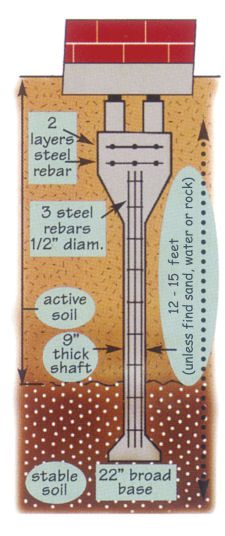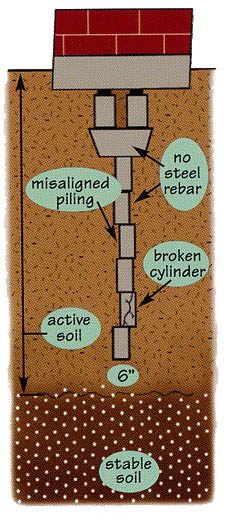There is a lot of mis-information being thrown at the homeowner these days. The best clarification is an examination of the repair method used by the contractor. There are distinct advantages and disadvantages of the most common methods of foundation repair used today. Celebrity endorsements are worthless because they are being paid to advertise a service they know nothing about. The experts in foundation repair are independent structural engineers – they are the ones with the specific knowledge and an engineering degree.
Bell Bottom Pier Method
The Bell Bottom Pier method of foundation repair is PERMANENT, Time-Tested, and Proven. It is simply the best. It is a poured, single unit of concrete with steel rebar and a large “foot” or bell bottom for support. It is stronger, is able to support more weight, and able to resist the forces of soil movement. A summary of the advantages and disadvantages is below.
The Proven and Permanent Solution |
|||||||||||||||||||||||||||||
 |
Advantages
Disadvantages
|
||||||||||||||||||||||||||||
Pressed Piling Method
The most common method of foundation repair in Sugar Land and the rest of Texas is the Pressed Piling or Pressed Piles method. This method of foundation repair has been labeled “temporary” and “useless” by the structural engineers at A-1 Engineering in San Antonio and Austin. It is an opinion based on known facts. This is the lowest quality method of foundation repair utilized in Texas but it is the most common because it is the most profitable for the foundation repair contractors. Pressed piles are concrete cylinders that are pressed into the ground under a home’s foundation. The hope is that the hydraulic system will drive the piles vertically into the ground. This can only be hope since there is no method to confirm the fact. If the concrete cylinders hit a rock, tree root, or crack during driving they can skew off on an angle and then they will offer little or no support for a concrete slab foundation. Although some more recent versions of this method have attempted to “tie” the concrete cylinders together with a cable or steel rods, it is a poor substitute for a single unit support structure. The 12 inch concrete cylinders will be individually pressured by the forces of soil movement. In addition, since the house itself is being used as the weight to drive the concrete piles into the ground, the foundation can be significantly damaged by crew error.
|
Advantages
Disadvantages
|
Request An Estimate: Schedule Your Free Home Foundation Inspection Today.
